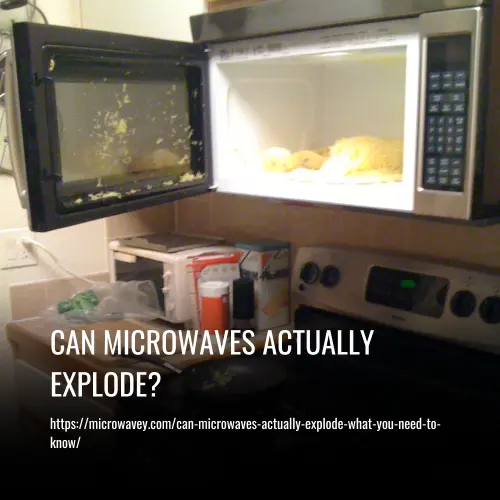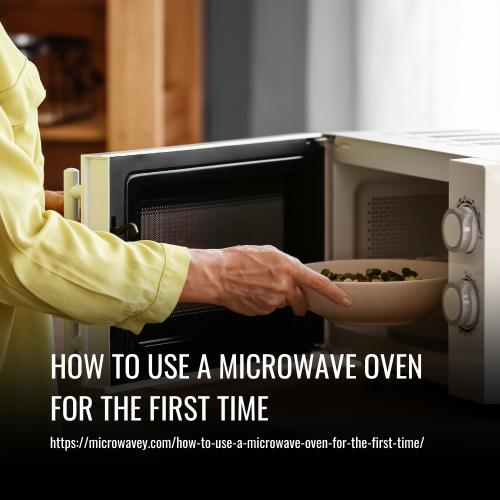How To Avoid Burns From A Microwave Oven
Microwave ovens are incredibly useful, but they can also be dangerous if not used properly. As a microwave oven safety expert, I’m here to tell you how to avoid burns when using this appliance in your home.
The key is understanding the power of microwaves and taking simple precautions while operating them. In this article, I’ll explain why it’s important to follow basic safety tips when working with a microwave oven, as well as provide detailed instructions on how to use one safely so you don’t get burned.
With these guidelines in hand, you’ll be able to enjoy all the benefits that come with having such an amazing kitchen tool without putting yourself at risk for painful injuries or worse.
What Are Microwaves?
Microwave ovens are appliances that utilize electromagnetic radiation to heat food. The energy is created in the form of microwaves which produce a magnetic field, and when these fields come into contact with water molecules they cause them to vibrate, creating thermal energy.
This is what heats up your food! Microwaves can be dangerous if handled incorrectly or exposed to too much radiation. It’s important to always take precautions such as standing at least two feet away from the microwave while it’s operating and never placing any metal inside the appliance.
To protect yourself further, you should also keep an eye on how long foods have been cooking for; exposure to microwaves for too long could result in hazardous effects due to overexposure of radiation and strong magnetic fields. Therefore, following all safety guidelines when using your microwave will help ensure no burns occur in the process.
What Are The Hazards Of Using A Microwave Oven?
Using a microwave oven is an efficient way to cook and heat food, but it also comes with certain risks. Among the hazards of using one are radiation exposure and uneven heat distribution.
The radiation from microwaves can be hazardous if you’re exposed to too much of it for long periods of time. To avoid this, keep your distance when operating a microwave oven; make sure that there isn’t anything blocking or obstructing the door as well.
Heat distribution in a microwave oven can be tricky at times. Uneven heating can cause burns on the surface or inside of food items, so it’s important to pay close attention while cooking, stirring regularly and checking temperatures throughout the process.
Additionally, always use mitts or pot holders when removing hot dishes from the device to protect yourself against burns. By following these simple instructions, you can enjoy safe operation without any risk of being burned by your microwave oven.
Safety Tips For Using A Microwave Oven
When using a microwave oven, it’s important to remember the heating trends. Cook times can vary depending on wattage and size of the appliance, as well as what types of food you are cooking.
To ensure that your meal has been cooked evenly throughout, be sure to practice safe cooking techniques such as stirring or rotating food halfway through the cook time. Additionally, always use oven mitts when removing heated dishes from the microwave – this will help prevent burns caused by steam and hot surfaces.
To further protect yourself against accidents in the kitchen, never attempt to operate a malfunctioning microwave oven; if you suspect an issue with your appliance contact an authorized service technician immediately.
With these safety tips in mind, you can enjoy delicious meals safely prepared in your microwave oven!
Proper Placement And Ventilation
Now that you know the safety tips for using a microwave oven, it’s time to learn about proper placement and ventilation.
To ensure your kitchen is safe when operating a microwave oven, always place the appliance at least 3 feet away from any combustible materials or open flames. This will keep you and your family at a safe distance while in use.
Additionally, never block airflow around the unit as this can lead to overheating of other appliances nearby.
It’s also important to familiarize yourself with your particular model’s ventilation requirements. Most modern models come equipped with vents on either side of the interior; however, some may require additional air circulation through an exhaust hood above.
Whether venting outside or into another room, make sure all ductwork is securely installed according to manufacturer specifications.
Remember: The best way to prevent burns from a microwave oven is by following these guidelines and understanding how your specific model functions!
How To Set The Power Level
When it comes to using a microwave oven, safety should be your top priority. A single mistake can cause serious burns and injuries, which is why understanding the right cooking techniques and power settings are essential.
To avoid harm while using a microwave oven, start by setting the correct power level for your food. This is usually determined by how much you’re making, what kind of dish you’re preparing, or if you’re reheating leftovers.
If in doubt, always err on the side of caution and select a lower power setting – this will ensure that your meal heats up evenly. Make sure not to leave any plastic containers inside as they may melt during cooking!
To get an even better result when heating foods like soup or stew, give them a stir halfway through so that everything cooks properly and there’s no risk of scalding yourself with hot spots.
How To Check For Leaks
Now that you know how to set the power level on your microwave oven, it’s time to move onto a crucial step: checking for leaks. Radiation testing is essential when it comes to microwaves – after all, these devices use magnetic waves in order to heat food and drinks.
Here’s what you need to do:
Place a cup of room-temperature water inside the oven with the door closed.
Set the power level at maximum before pressing start.
Stand outside of the kitchen while the appliance runs for two minutes (and don’t forget to wear protective gear).
If you feel any warmth or see any light coming from around the edges of the door, this indicates radiation leakage which can be hazardous if exposed over long periods of time.
If there are any signs of leakage present, immediately unplug the device and contact a professional technician who will be able inspect it more closely and ensure your safety. It may sound like an arduous process but trust us – taking these steps now can save you lots of trouble down the line!
How To Operate The Door
As a microwave oven safety expert, I would like to start off by talking about an all too common experience. Have you ever opened the door of your microwave, only to feel its heat radiating out? It’s probably not the most pleasant feeling in the world!
| To avoid this from happening again, it is important to understand how to properly use the door handle and latch on your microwave oven. | Door Handle | Door Latch |
|---|---|---|
| Push firmly | Pull down | |
| Do not twist | Lift up |
It is also important that you close the door completely after each use when operating a microwave oven; even a slight gap can cause hot air or steam buildup inside the appliance which could lead to burns. Lastly, be sure to keep anything flammable away from the front of your microwave while it is in operation as any contact with these objects may lead to injury or property damage. In short, follow these simple steps for safe and effective operation of your microwave’s door.
Foods To Avoid In The Microwave
Now that you know how to operate the door of a microwave oven, it’s important to be aware of the types of food that are safe and unsafe to reheat in the appliance. The key is understanding cooking times and proper food preparation when putting items into your microwave.
When using the microwave, always check for foods with metal packaging such as canned soup or frozen dinners – these should never go inside! If you plan on heating pre-packaged meals, make sure to remove any plastic film before microwaving.
Additionally, ensure not to overload your unit with too much food as this can lead to an uneven distribution of heat which could cause burns.
It’s also important to remember that some foods like eggs or potatoes must be pierced prior to cooking otherwise they may explode due to built up steam pressure.
Lastly, keep track of how long each item cooks so nothing gets over cooked or undercooked and becomes a potential hazard.
Cleaning And Maintenance
A common cause of burns from a microwave oven is improper cleaning. To prevent this, it’s important to use the right cleaning supplies and techniques when taking care of your appliance.
Take for example Mrs. Anderson: she recently suffered a nasty burn on her arm after using a dirty microwave plate that she had neglected to clean properly.
To make sure you don’t suffer the same fate as Mrs. Anderson, start by gathering some basic cleaning supplies such as dish soap, baking soda, vinegar, and cloths or sponges. Be sure to unplug the microwave before beginning any sort of maintenance work; safety first!
Use warm water with mild detergent or baking soda to scrub away food particles and smudges from its surfaces – never use harsh abrasives like steel wool pads which could damage its finish.
Finally, try out some easy cooking tips like splitting up dishes into multiple containers so they heat more evenly in the oven and avoid overcooking them.
Common Microwave Oven Safety Questions
Cleaning and maintaining your microwave oven regularly is essential to ensure safe use. Now that you have taken the necessary steps, it’s time to look at common safety questions about microwaving food.
When cooking with a microwave oven, there are some important things to keep in mind. First of all, be mindful of different methods of food preparation: certain types of containers may not be suitable for microwaving as they can cause burns or other injuries due to their construction material.
Additionally, foods should always be cooked according to package instructions. This will help prevent radiation exposure which could otherwise pose health risks if left unchecked.
It’s also crucial to never operate an empty microwave oven; this can damage the appliance itself and potentially start a fire as well.
By following these key points, you can enjoy delicious meals while remaining safely away from any potential harm caused by using your microwave oven incorrectly.
Conclusion
As an expert in microwave oven safety, I must stress the importance of following all safety guidelines.
From proper placement and ventilation to understanding how to operate the door, using a microwave can be done safely if you follow these tips.
It is also important to remember that certain foods should not be cooked or reheated in a microwave as they may cause burns due to their shape or texture.
Lastly, regular maintenance and cleaning will help ensure your microwave continues to work properly without any issues.
Overall, microwaves are great for quickly heating food but it’s essential that we use them responsibly and take the necessary precautions when operating them.
As technology advances, so does our reliance on microwaves – just don’t forget about basic safety protocol from decades ago!
With this knowledge at hand, you can now enjoy your meals with peace-of-mind knowing you’ve taken all the necessary steps to avoid any potential accidents or injuries.



